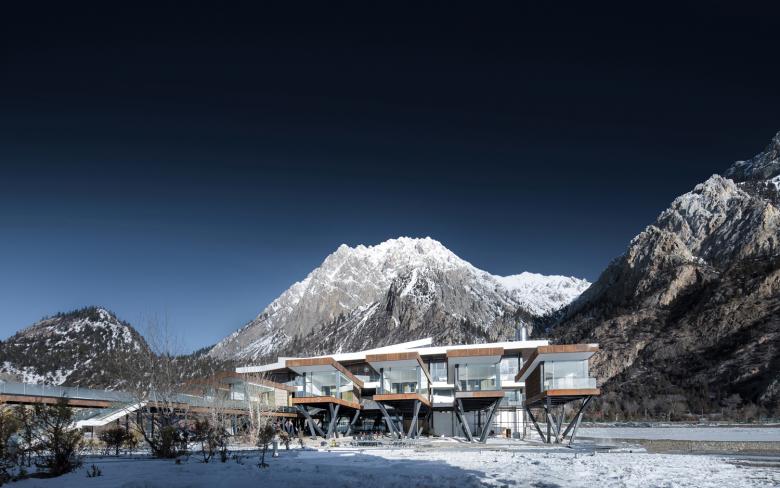Tibetan Coolness
Eduard Kögel
15. septiembre 2017
Photo: Arch-exist Photography
Lake Ranwu lies about halfway between Lhasa in Tibet and Chengdu in the Chinese province of Sichuan, on National Highway 318. The lake is roughly 20 kilometres long, 1.5 kilometres wide, and is separated into lower, middle and upper sections. The surrounding landscape has a natural beauty, and the snow-capped mountain peaks of the Himalayas reinforce the alpine character of the site. The highway is an important circulation spine for the Himalayas which many tourists travel in order to experience this natural beauty, with various types of vehicles; there are cyclists who carry their luggage on the bike, motorists who drive in private cars and groups in tour buses.
Project location: Ranwu Lake, Tibet
Total land area: 46,668 square meters
Total building area: 2,400 square meters
Project time: 2016 -2017
Designed by: Arch-HERMIT Architects / Chengdu
Chief architect: Pan Youcai
Landscape and planning designer: Yang Zhe & Li Tianjing
Interior designer: He Miao, Jiang Tao, Zhang Yu & Qin Miaosen
Architectural photographer: Arch-exist Photography
Photo: Arch-exist Photography
Chengdu-based architect Pan Youcai was commissioned to design a campground with additional facilities, as a supply station for such travellers. The selected site is located on the northern shore of the Lake Ranwu, near to National Highway 318, on terrain sloping towards the water with a spectacular view across the lake to the mountain range on the opposite side. The imposing topography and the rough stony landscape of the mountains are softened by pine trees and the azalea flowers, which grow naturally in the region.
Photo: Arch-exist Photography
The supply centre includes a travel information centre, exhibition rooms, a car repair shop, a restaurant and a tearoom, together with facilities for children and for campers. The architects structured the sloping terrain from the road to the lake into three functional zones: the upper level adjacent to the highway has a car park with five tour-bus parking spaces and more than 175 spaces for cars, as well as a 20-meter-high sign announcing the centre to the highway. All buildings are located midway down the slope and project out of the hillside, with the terrain underneath them covered by gravel. The campsite is located between the buildings and the lakeshore.
Photo: Arch-exist Photography
The above-mentioned functions are contained in a central, 80 meter long building following the contour line, which floats on supports above the ground. Thus the platform affords all functions and a spectacular view over the landscape, without cutting off access to the lake. The building is reached via ramps and stairs that take advantage of the natural contours of the terrain. So as not to interrupt the view, the main building has a glass façade, and the public viewing platform to its front has a glass balustrade.
Photo: Arch-exist Photography
To the front of the viewing platform are eight small hotel units, with spectacular view towards the lake. These units are accessed by a bridge and are positioned at varying heights, so as not to impair views from the main building and viewing platform.
Photo: Arch-exist Photography
The buildings are of prefabricated steel construction, erected on site. The material palette comprising local wood and pebbles, grey steel construction, weathered Cor-Ten steel plates, and glass, blends the new complex into the landscape. The colours white and red refer in an abstract way to the local culture, and make the buildings disappear in the winter. The harsh weather and the long winter may be a challenge for the architecture, but the sensitively designed elements fit very well into this specific environment.
Photo: Arch-exist Photography
In such a remote area, the supply centre must serve differing visitor demands, regardless of whether they come as pilgrims, cyclists, drivers, hotel guests or campers. For all these visitors, it will be a special experience in terms of nature and contemporary design, within a breath-taking environment. With this destination at Ranwu Lake, the new urban middle class can feel at home, while the local population has the opportunity to benefit from the development of the tourist economy.

















